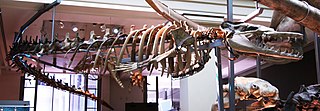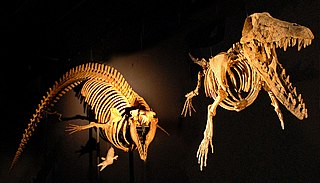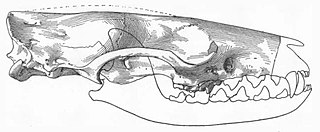
Tetraodontidae is a family of primarily marine and estuarine fish of the order Tetraodontiformes. The family includes many familiar species variously called pufferfish, puffers, balloonfish, blowfish, blowers, blowies, bubblefish, globefish, swellfish, toadfish, toadies, toadle, honey toads, sugar toads, and sea squab. They are morphologically similar to the closely related porcupinefish, which have large external spines. The scientific name refers to the four large teeth, fused into an upper and lower plate, which are used for crushing the hard shells of crustaceans and mollusks, their natural prey.

The Lacertidae are the family of the wall lizards, true lizards, or sometimes simply lacertas, which are native to Afro-Eurasia. It is a diverse family with at about 360 species in 39 genera. They represent the dominant group of reptiles found in Europe.

Basilosaurus is a genus of large, predatory, prehistoric archaeocete whale from the late Eocene, approximately 41.3 to 33.9 million years ago (mya). First described in 1834, it was the first archaeocete and prehistoric whale known to science. Fossils attributed to the type species B. cetoides were discovered in the United States. They were originally thought to be of a giant reptile, hence the suffix "-saurus", Ancient Greek for "lizard". The animal was later found to be an early marine mammal, which prompted attempts at renaming the creature, which failed as the rules of zoological nomenclature dictate using the original name given. Fossils were later found of the second species, B. isis, in 1904 in Egypt, Western Sahara, Morocco, Jordan, Tunisia, and Pakistan. Fossils have also been unearthed in the southeastern United States and Peru.

Orthocerida, also known as the Michelinocerida, is an order of extinct orthoceratoid cephalopods that lived from the Early Ordovician possibly to the Late Triassic. A fossil found in the Caucasus suggests they may even have survived until the Early Cretaceous, and the Eocene fossil Antarcticeras is sometimes considered a descendant of the orthocerids although this is disputed. They were most common however from the Ordovician to the Devonian.

Tetraodon is a genus in the pufferfish family (Tetraodontidae) found in freshwater in Africa. It is the type genus of the family and historically included numerous other species; several Asian species were moved to the genera Dichotomyctere, Leiodon and Pao in 2013.
Driftwood Canyon Provincial Park is a provincial park in British Columbia, Canada. Driftwood Canyon Provincial Park covers 23 ha of the Bulkley River Valley, on the east side of Driftwood Creek, a tributary of the Bulkley River, 10 km northeast of the town of Smithers. The park is accessible from Driftwood Road from Provincial Highway 16. It was created in 1967 by the donation of the land by the late Gordon Harvey (1913–1976) to protect fossil beds on the east side of Driftwood Creek. The beds were discovered around the beginning of the 20th century. The park lands are part of the asserted traditional territory of the Wet'suwet'en First Nation.

The Gempylidae are a family of perciform fishes commonly known as snake mackerels or escolars. The family includes about 25 species.

Archaeoceti, or Zeuglodontes in older literature, is a paraphyletic group of primitive cetaceans that lived from the Early Eocene to the late Oligocene. Representing the earliest cetacean radiation, they include the initial amphibious stages in cetacean evolution, thus are the ancestors of both modern cetacean suborders, Mysticeti and Odontoceti. This initial diversification occurred in the shallow waters that separated India and Asia 53 to 45 mya, resulting in some 30 species adapted to a fully oceanic life. Echolocation and filter-feeding evolved during a second radiation 36 to 35 mya.

Zignoichthys oblongus is an extinct prehistoric relative of the pufferfish and porcupine fish that lived during the Lutetian epoch of the Eocene. Z. oblongus' fossils are found from the Monte Bolca lagerstätte of what is now Italy.
Paleontology or palaeontology is the study of prehistoric life forms on Earth through the examination of plant and animal fossils. This includes the study of body fossils, tracks (ichnites), burrows, cast-off parts, fossilised feces (coprolites), palynomorphs and chemical residues. Because humans have encountered fossils for millennia, paleontology has a long history both before and after becoming formalized as a science. This article records significant discoveries and events related to paleontology that occurred or were published in the year 1954.

Acherontemys is an extinct genus of turtle from Miocene of United States.
Palimphyes is an extinct genus of prehistoric euzaphlegid bony fish related to the escolars and snake mackerels. The various species lived as deepwater mesopelagic predators in the Tethys and Paratethys oceans, with fossils of ten species found in Paleocene to Oligocene strata of the Swiss Alps, the Carpathian and Caucasus Mountains, Iran, India, and Turkmenistan.
Caucasichthys is an extinct genus of perciform bony fish which existed in Russia during the middle Eocene epoch. It is known from the Gorny Luch locality of northern Caucasus. It was first named by Alexandre F. Bannikov, Giorgio Carnevale and N. V. Parin in 2011 and the type species is Caucasichthys kumaensis. The generic name comes from Caucas, from Caucasus and ichthys, fish. The specific name is derived from the Kuma Horizon, where the fossils were found.
Bahndwivici is an extinct genus of lizard known from a nearly complete and articulated skeleton discovered in rocks of the Green River Formation of Wyoming, United States. The skeleton is very similar to that of the modern Chinese crocodile lizard, Shinisaurus.
Afairiguana avius is an extinct iguanid lizard known from a nearly complete and articulated skeleton discovered in rocks of the Early Eocene-aged Green River Formation of Wyoming, United States. As of the initial description, the skeleton represents the oldest complete iguanian from the Western Hemisphere, and is the oldest representative of the extant iguanid family of anoles, Polychrotidae.

The Bridger Formation is a geologic formation in southwestern Wyoming. It preserves fossils dating back to the Bridgerian and Uintan stages of the Paleogene Period. The formation was named by American geologist Ferdinand Vandeveer Hayden for Fort Bridger, which had itself been named for mountain man Jim Bridger. The Bridger Wilderness covers much of the Bridger Formation's area.

The San Jose Formation is an Early Eocene geologic formation in the San Juan Basin of New Mexico and Colorado.

Viverravus is an extinct genus of placental mammals from extinct subfamily Viverravinae within extinct family Viverravidae, that lived in North America, Europe and Asia from the middle Paleocene to middle Eocene.
Ernestokokenia is an extinct genus of mammal, belonging to the Didolodontidae. It lived during the Early Eocene and the Middle Eocene, and its fossils were discovered in South America.












